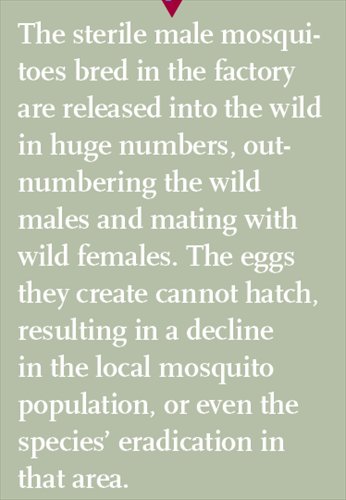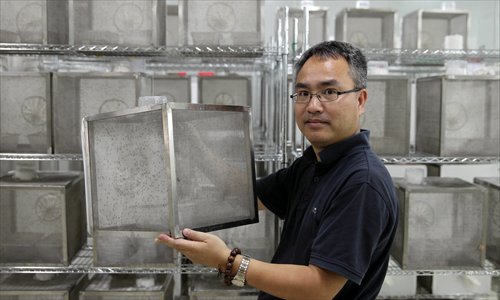Chinese biologists offer solution to Brazilian Zika panic
Chinese biologists offer solution to Brazilian Zika panic with mosquito-controlling techniques
A method of suppressing the disease-carrying mosquito population developed mainly by Chinese scientists may be used in Brazil to help contain the Zika outbreak. One of the key scientists behind development of the technique shares his insights, expectations and ambitions before he heads to the South American country for an international conference on the Zika virus.

A worker sprays a pesticide in an effort to kill mosquitoes in Guangzhou, capital of South China's Guangdong Province, on April 22, 2015. Photo: CFP
A professor from Guangzhou's Sun Yat-sen University has been invited to Brazil to help eradicate Aedes mosquitoes, the pest spreading the Zika virus, which is suspected of causing over 4,000 babies infected in the womb to be born with microcephaly - abnormally small heads - in the country.
The five-day Brasilia conference, co-organized by the International Atomic Energy Agency (IAEA) and the Brazilian Ministry of Health starting February 22 local time, will host world-leading experts to discuss and propose approaches to control the mosquito population and fight the Zika epidemic, said Xi Zhiyong, who also teaches at Michigan State University. Xi is an expert in vector management, the process by which animals and insects that cause diseases are controlled or eradicated.
Chinese research is playing an important role in this battle, he noted.
"The technology we have researched and developed can be used to prevent and control all mosquito-born diseases, including Zika, malaria, dengue, and yellow fever," he told the Global Times on Sunday.
Following years of research and field tests, their technique, in which they produce mosquitoes that carry Wolbachia, a common bacteria that stops viruses from replicating in mosquitoes and hampers the insects' reproduction, has turned out to be very successful in suppressing the insect, Xi said.
If they win the support of the Brazilian government, Xi said his research team can build a mosquito factory in the country to stem the spread of Zika.
As only female mosquitoes bite animals and transmit diseases, the sterile male mosquitoes bred in the factory are released into the wild in huge numbers, outnumbering the wild males and mating with wild females. The eggs they create cannot hatch, resulting in a decline in the local mosquito population, or even the species' eradication in that area, according to Xi, who directs the Sun Yat-sen University-Michigan State University Joint Center of Vector Control for Tropical Diseases.
On Shazai Island in Guangzhou, South China's Guangdong Province, a region plagued by dengue, they have built a mosquito factory which Xi claims is the world's largest, able to produce 20 million sterile male mosquitoes per week.
According to the Xinhua News Agency, since October 2015, Brazil has registered 508 cases of microcephaly in newborns, with nearly 4,000 other suspected cases currently being examined.

Rio de Janeiro, the host city of the 2016 Olympic Games, has faced pressure to cancel the event though only a small number of cases have been reported in the city. The authorities have tried to ease people's worries, explaining that as the Games will be held during Brazil's winter, the relatively cooler weather will limit the mosquito population and therefore transmission of the disease. They have however advised pregnant women not to attend.
The third Zika case in the Chinese mainland was reported in Shenzhen, Guangdong on February 14 when a 38-year old passenger returned from a trip to Samoa. The patient, from Yiwu, Zhejiang Province, was quarantined, but his temperature has returned to normal, according to a report by the Zhejiang health authorities on Friday.
WHO statistics show that the virus is continuing to spread "explosively" and that a total of 48 countries and regions have reported Zika cases.
Mosquitoes are behind the spread of many diseases. More than half a million people worldwide die from mosquito-borne diseases each year, the WHO said, and as such research into reducing their numbers has been a key priority for many biotechnology firms.
Oxitec, a British subsidiary of US biotechnology company Intrexon, released 25 million genetically modified (GM) mosquitoes in one neighborhood of the Brazilian city of Piracicaba between April and November 2015, according to a recent Reuters report. The male mosquitoes are modified so their offspring will die before they reach adulthood and are able to reproduce, said the report.
The company, which has since announced it will build a second facility in Brazil, claimed that they were able to reduce the number of wild Aedes mosquito larvae in the area by 82 percent.
The sentiment that a world without mosquitoes would be better is widely shared, but some biologists' views differ, according to a 2010 report by nature.com.
"Mosquitoes are delectable things to eat and they're easy to catch," aquatic entomologist Richard Merritt at Michigan State University was quoted as saying by the report. Merritt added that without their larvae, hundreds of species of fish, for example the mosquitofish (Gambusia affinis), would have to change their diet to survive or die out, which will affect the food chain.
But according to the American Mosquito Control Association, a US nonprofit organization, mosquitoes are not essential to the ecosystem. They serve as food sources for a variety of organisms but are not crucial to any species' survival, the association says on its website. It also says it is virtually impossible to totally eradicate them thanks to their extraordinary adaptability.

Professor Xi Zhiyong displays his mosquito-breeding facilities in Guangzhou. Photos: CFP
How does Wolbachia technology compare with GM anti-mosquito methods? How effective is Wolbachia? When will it be put into large-scale application? To answer these questions, Global Times reporter Huang Jingjing (GT) interviewed Xi Zhiyong (Xi), professor and director of the Sun Yat-sen University-Michigan State University Joint Center of Vector Control for Tropical Diseases.
GT: What are you going to do at the conference? How do you rate the prospects of the technology your team has developed?
Xi: The conference, targeting the outbreak of the Zika virus, is co-organized by the IAEA and the Brazilian Ministry of Health. Inviting the world's leading experts on integrated vector management, the meetings will focus on using integrated vector management with Sterile Insect Techniques (SIT) to control the Aedes mosquito population. Short-term and long-term plans to suppress the Zika epidemic are expected to be made.
Our field test of the technique last year turned out to be very successful. I hope to present the progress we have made at the conference, its feasibility and the huge potential for its application. If we win support from the Brazilian government, I'd like to build a mosquito factory in the country and use our technology to crack down on the spread of Zika virus.
I'm very optimistic about the application of the technology. Aedes mosquito population control is urgently needed in South America, Southeast Asia, South Asia and Africa. What we need to do now is consolidate our technology and reinforce its effectiveness and credibility and scale up production.
GT: Please describe the productivity of the mosquito factory at Shazai Island. Is it the largest such facility in the world?
Xi: The factory produced 1 million sterile male mosquitoes per week last year. It is the world's largest mosquito factory. With four production units, it covers an area of more than 3,500 square meters. Each unit is designed to produce up to 5 million male mosquitoes per week, which means the factory's capacity could reach 20 million per week. But last year, we only put part of one unit into use. Our goal is to produce 2.5 billion male mosquitoes per week in the next five to 10 years, and help to eradicate almost all the Aedes mosquitoes in major residential areas across South China.
GT: Where are the mosquitoes you have produced? When will they be widely released? Will the government buy the mosquitoes made in your factory?
Xi: We released sterile male mosquitoes which don't bite. They competed with wild males and mate with females, which laid eggs that can't develop. Gradually, the mosquito population in the island died. Male mosquitoes in nature live for two weeks, and the females can live up to four weeks.
Last year we were testing just on Shaizai Island. This spring we will work in additional sites to repeat our success last year. It's expected that the technology will be used on a large scale within two or three years.
The project has received the government's support from the beginning. It is nonprofit as it's part of the prevention and control of diseases which threaten public health. We are just helping the government build a new method for disease prevention and control.
GT: According to a recent Reuters report, Oxitec, the UK subsidiary of US biotechnology company Intrexon, will build a second facility in Brazil using genetic modification to reduce the mosquito population and the spreading of Zika and other dangerous viruses. What are the advantages of your technology compared with theirs?
Xi: The greatest merit of our technology is that we use bacteria that exists in nature. That's also why the field tests of the technology are easily approved by governments. Now many government-funded research institutes are conducting field trials of this technology, including the US, Australia, China, Singapore, Vietnam, Brazil and Columbia.
The field test results on Shazai Island last year showed that we could nearly eliminate the mosquitoes' larvae in the zone with consistent releases. In the whole month, we detected only one larvae hatched from the eggs collected from the field. From the current data, I think out technology is more attractive.
GT: Was the technology using Wolbachia bacteria independently invented by Chinese scientists?
Xi: Our field trial was an international collaborative project led by Chinese scientists, with all core technology developed in China. Over 90 percent of the researchers working on the project are Chinese and the project's major financial supporter is the Chinese government, the Guangdong Provincial Department of Science and Technology. But when the project was launched five years ago, it was supported by the Foundation of the National Institute of Health through the Grand Challenges in Global Health Initiative of the Bill and Melinda Gates Foundation. Besides, I am a professor at Michigan State University and the IAEA is a close partner.
With the assistance of IAEA, we designed and manufactured an X-ray radiation insect sterilization instrument last year to raise our productivity efficiency. Now several countries have ordered the instrument from us. In addition, we are going to cooperate with an Israeli company this year to study using drones to release mosquitoes.
Currently, there are around eight teams in the world engaging in the research of the vector management approach using Wolbachia, all of this technology is based on our breakthrough that was published in the Science journal in 2005.
It is expected that more and more countries will get involved. I wish to promote the technology at the conference in Brazil, which representatives from more than 20 countries and regions, mainly from South America, will attend. In mid-March, sponsored by the IAEA, delegates from 20 Southeast Asian, South Asian and African countries will attend a meeting held in Sun Yat-sen University in Guangzhou and they will visit our factory and field release site.
Newspaper headline: Squash the bug